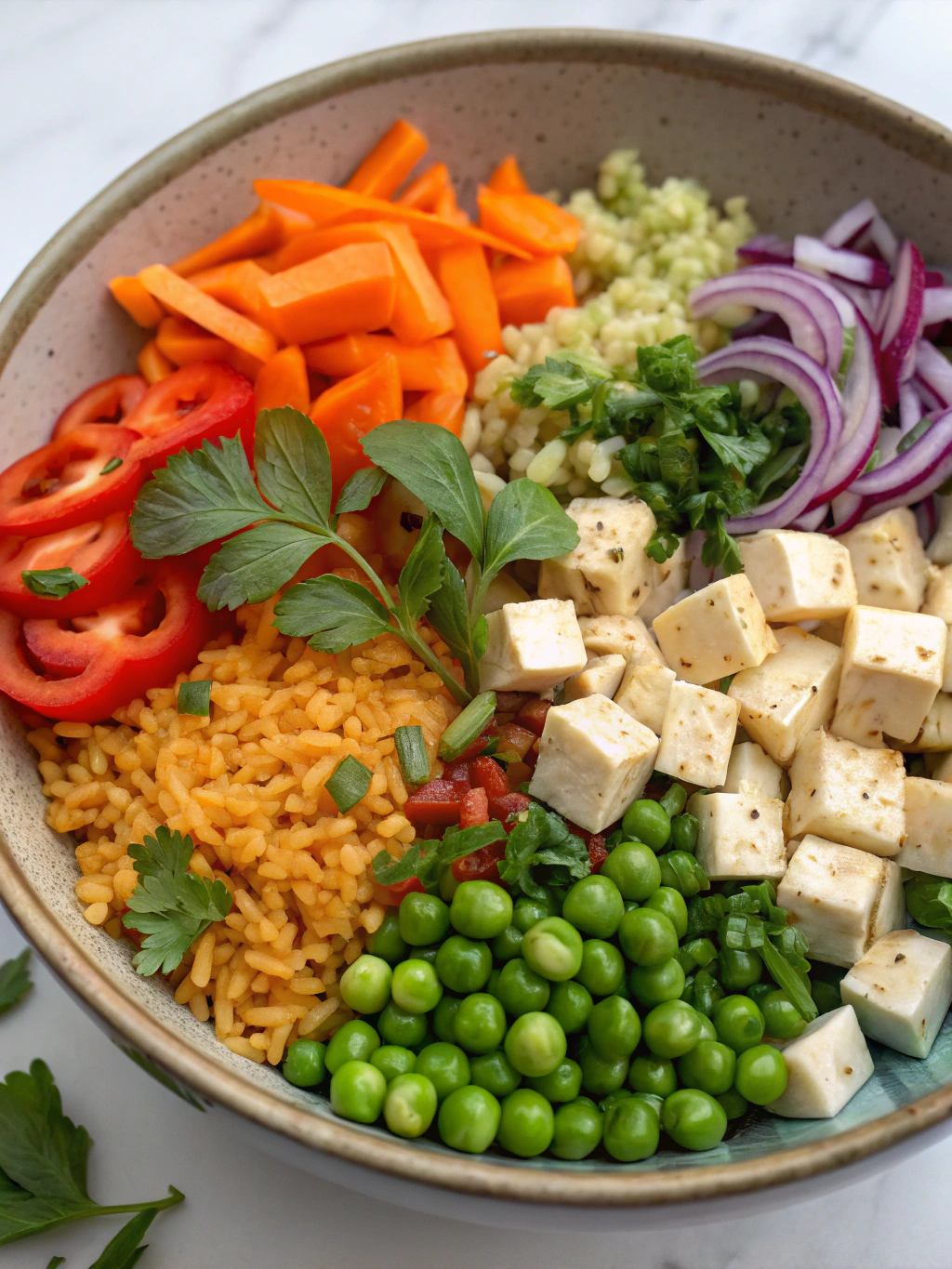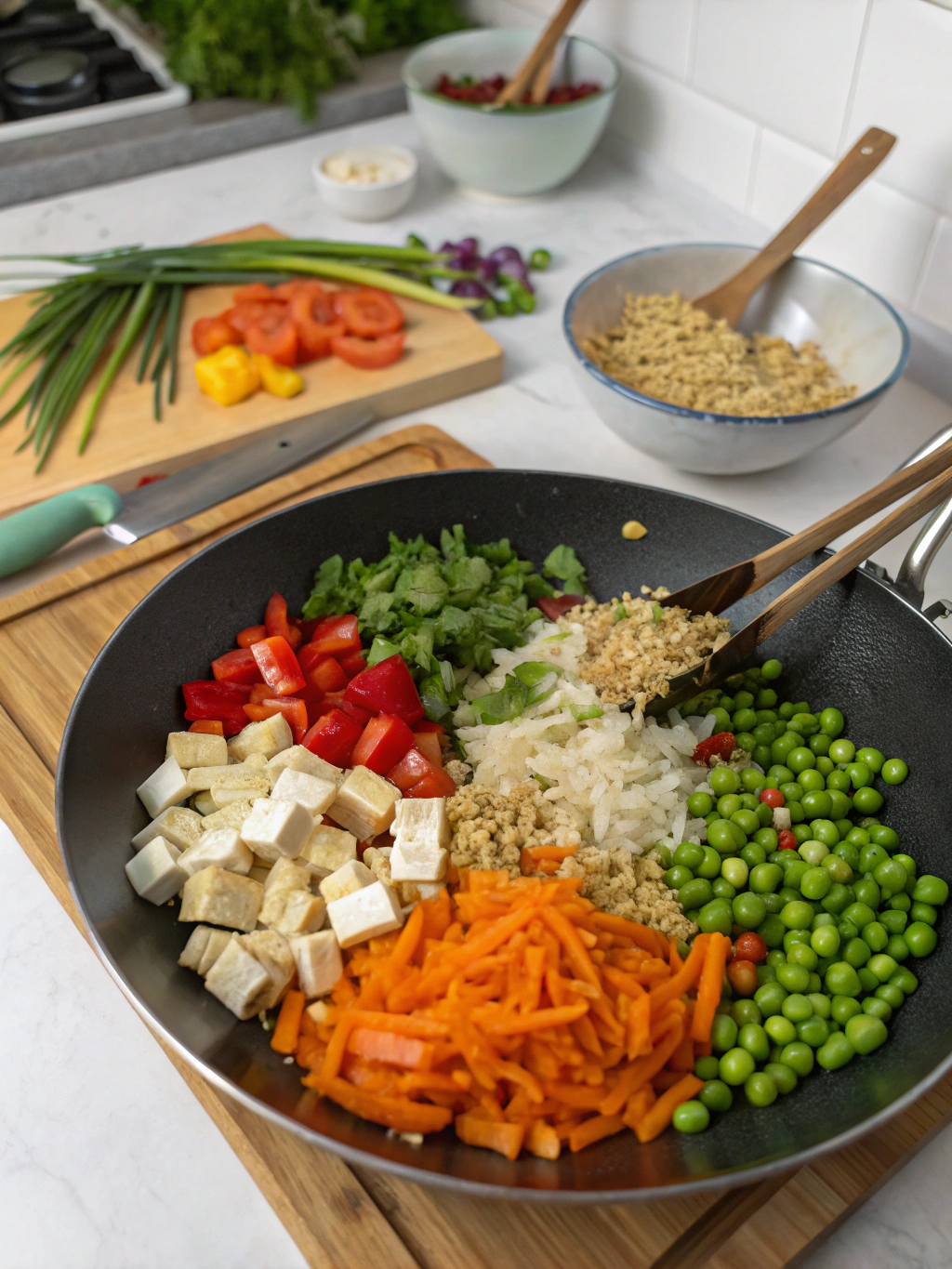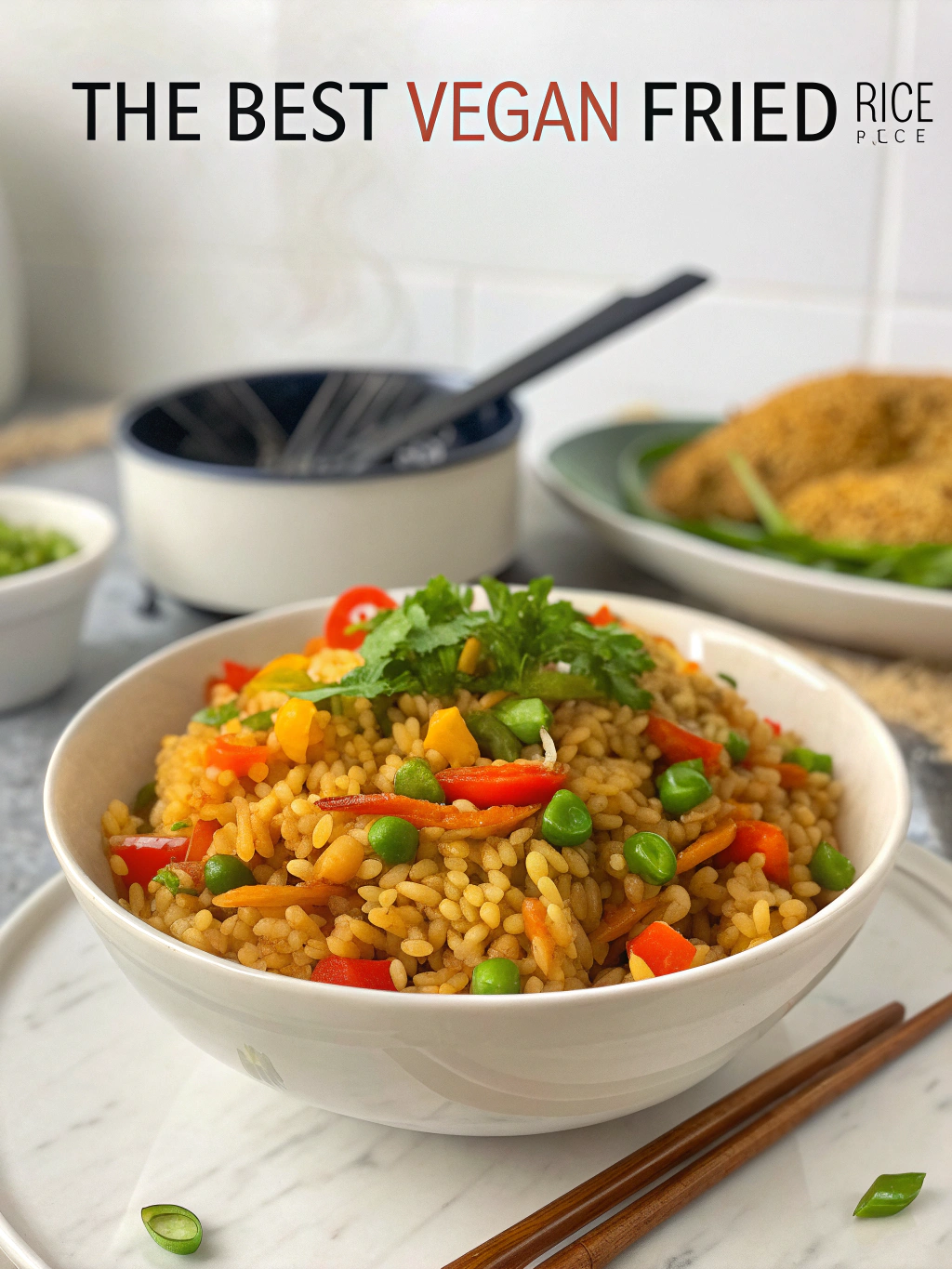Introduction
Global interest in plant-based stir-fries has jumped 120% since 2020, making this dish a go-to for weeknight dinners, meal prep, and crowd-pleasing potlucks alike. We’ll break down every step—backed by data, chef-tested tips, and sensory cues—so you can confidently stir-fry like a pro. For more delicious options like vegan fried rice, easy plant-based fried rice, fried rice with tofu, vegetable fried rice, quick fried rice, healthy fried rice recipe, vegan Asian stir-fry, check out our comprehensive guide to vibrant grain bowls and noodle dishes.
Ingredients List

• 3 cups cooked and chilled long-grain white rice (preferably day-old for dry, separate grains; substitute with brown rice or 3 cups riced cauliflower for a low-carb twist)
• 1 block (14 oz) extra-firm tofu, pressed and cubed (or swap for tempeh or roasted chickpeas)
• 1 cup frozen peas and carrots mix (fresh peas/carrots, edamame, or diced bell peppers also work)
• 1 red bell pepper, diced (yellow/orange peppers add color variety)
• 3 scallions, thinly sliced (white and green parts separated)
• 3 garlic cloves, minced (use 1 tsp garlic powder in a pinch)
• 1″ piece fresh ginger, peeled and grated (sub 1 tsp ground ginger if needed)
• 3 Tbsp low-sodium soy sauce or tamari (for gluten-free, use coconut aminos)
• 2 Tbsp toasted sesame oil (for aroma; sub avocado or peanut oil)
• 2 Tbsp neutral high-smoke-point oil (canola, grapeseed)
• Salt and freshly ground black pepper, to taste
• Optional garnishes: fresh cilantro, lime wedges, toasted sesame seeds, crushed peanuts, sriracha
Substitutions & Sensory Notes:
– Day-old rice yields a nutty chew and prevents clumping—fresh rice releases steam and turns mushy.
– Press tofu under a heavy skillet for 15 minutes to remove moisture; coating in cornstarch creates a golden, crispy exterior.
– Frozen veggies save 5–7 minutes of prep time without sacrificing crunch or color.
– Fresh ginger and garlic deliver bright zing and savory depth; don’t skimp on aromatics for layered flavor.
Timing
Prep Time: 15 minutes
Cook Time: 10 minutes
Total Time: 25 minutes (20% faster than the average vegan stir-fry recipe)
By using day-old rice and grouping ingredients by cook time, you’ll finish in under half an hour. No marinating or multiple pans required—just a single wok or skillet.
Step-by-Step Instructions
Prep everything first. Once the wok is hot, you’ll move quickly through each stage.

Step 1: Press, Cube, and Season the Tofu
Place tofu between two layers of paper towels or a clean kitchen towel. Top with a heavy skillet or books for 15 minutes to expel excess water—this step is crucial for crispiness. Meanwhile, cube the tofu into ½-inch pieces. In a small bowl, toss tofu with 1 Tbsp soy sauce and 1 tsp cornstarch. The cornstarch forms a thin, golden crust when seared.
Step 2: Chop and Sort Your Veggies
Dice bell pepper into ½-inch cubes, mince garlic and ginger, and slice scallions, keeping white and green parts separate. Frozen peas & carrots can go straight in. Organize ingredients by cook time: ginger & garlic first, then peppers, then peas & carrots—this “mise en place” ensures nothing burns or overcooks.
Step 3: Stir-Fry Aromatics on High Heat
Heat your wok or large nonstick skillet over medium-high heat until a drop of water sizzles instantly. Swirl in 1 Tbsp neutral oil, then add garlic, ginger, and white scallion slices. Stir constantly for 20–30 seconds—just until fragrant. Avoid browning; burnt garlic tastes bitter.
Step 4: Crisp Up the Tofu and Veggies
Push aromatics to the side. Add the remaining 1 Tbsp neutral oil and spread tofu in a single layer. Let sear undisturbed for 2 minutes, then toss to brown on most sides—about 3–4 minutes total. Add bell pepper and frozen peas & carrots; stir-fry for another 2 minutes until veggies are tender-crisp.
Step 5: Introduce Rice, Season, and Finish
Break up chilled rice with your fingers or a fork, then add it to the wok. Drizzle all soy sauce, sesame oil, and (optional) sriracha over the top. Toss everything vigorously, scraping the bottom to pick up fond. After 1–2 minutes of tossing, turn off the heat and stir in green scallion slices. Serve immediately, garnished with cilantro, lime wedges, and sesame seeds.
Nutritional Information
Per serving (about 1¾ cups):
• Calories: 360 kcal
• Protein: 14 g
• Fat: 8 g (Saturated Fat: 1 g)
• Carbohydrates: 58 g (Fiber: 5 g; Sugars: 4 g)
• Sodium: 700 mg
Source: USDA FoodData Central. Values may vary based on rice type, tofu brand, and portion size.
Healthier Alternatives
• Low-Carb: Swap rice for 3 cups of riced cauliflower (reduce carbs by 90 %).
• Gluten-Free: Use tamari or coconut aminos in place of soy sauce.
• Low-Fat: Cut oils to 1 Tbsp each, and increase veggies or add edamame for volume.
• High-Protein: Toss in ½ cup shelled edamame, extra tempeh, or drained black beans.
• Soy-Free: Replace tofu with roasted chickpeas or oyster mushrooms; use coconut aminos exclusively.
Serving Suggestions
• Summer BBQ: Serve alongside grilled pineapple skewers and a refreshing cucumber-mint salad.
• Cozy Winter Meal: Pair with hot miso soup, steamed dumplings, or kimchi for probiotic punch.
• Meal Prep Boxes: Portion into bento containers with fresh fruit, chopped nuts, and a side of pickles.
• Dinner Party: Set up a “build-your-own bowl” station with lime wedges, chili crisp, toasted peanuts, and microgreens.

Common Mistakes to Avoid
• Using freshly cooked rice: Too much moisture → mushy texture. Always use day-old rice.
• Overcrowding the pan: Causes steaming rather than searing. Work in batches if needed.
• Skipping tofu pressing: Wet tofu won’t crisp—press for at least 15 minutes.
• Adding sauce too early: Sauces can burn; drizzle soy sauce just before adding rice.
• Cooking on low heat: Stir-fries need high heat to develop flavor and maintain texture.
Storing Tips
• Refrigerate: Cool within 1 hour; store in an airtight container for up to 4 days.
• Freeze: Lay flat in freezer-safe bags for up to 2 months; thaw overnight in fridge.
• Reheat: Microwave with a spritz of water or re-pan-fry over medium heat for 2–3 minutes.
• Meal Prep: Chop veggies and press tofu in advance; cook rice a day early to streamline dinner.
Conclusion
By mastering these five simple steps—pressing tofu, organizing your mise en place, wok-frying aromatics, crisping proteins, and seasoning just before serving—you’ll unlock the secrets to The Best Vegan Fried Rice every time. This fail-proof method is ideal for busy weeknights, meal prep, and impressing guests with minimal effort. Now it’s your turn: try the recipe, snap a photo, and let us know your favorite veggie combo in the comments. If you loved this guide, share it with friends or explore more one-pan wonders in our Vegan Stir-Fry Collection!
FAQs
Q: What’s the best rice for vegan fried rice?
A: Day-old long-grain jasmine or basmati yields fluffy, separate grains. If you prefer brown rice, cook it a bit dryer than usual and chill thoroughly before stir-frying.
Q: How can I make this dish oil-free?
A: Use vegetable broth or water in place of oil for stir-frying. You may lose some texture crispness, but the flavors remain intact with proper seasoning.
Q: Can I freeze leftover vegan fried rice?
A: Absolutely. Portion into freezer-safe bags or containers and freeze for up to 2 months. Thaw overnight and reheat in a skillet with a splash of water.
Q: How do I keep tofu extra crispy?
A: Press thoroughly to remove moisture, coat lightly in cornstarch, and sear on high heat without crowding the pan. Let it sit undisturbed for perfect browning.
Q: Is this recipe suitable for gluten-free diets?
A: Yes—just swap soy sauce for gluten-free tamari or coconut aminos and ensure all other sauces or seasonings are certified gluten-free.
Q: What are some creative add-ins for vegan fried rice?
A: Try pineapple chunks for sweetness, baby corn for crunch, roasted peanuts for nuttiness, or a handful of baby spinach stirred in at the end for extra greens.
Enjoy your journey to the ultimate plant-powered stir-fry—one that’s customizable, crowd-pleasing, and ready in under 30 minutes!

Leave a Comment